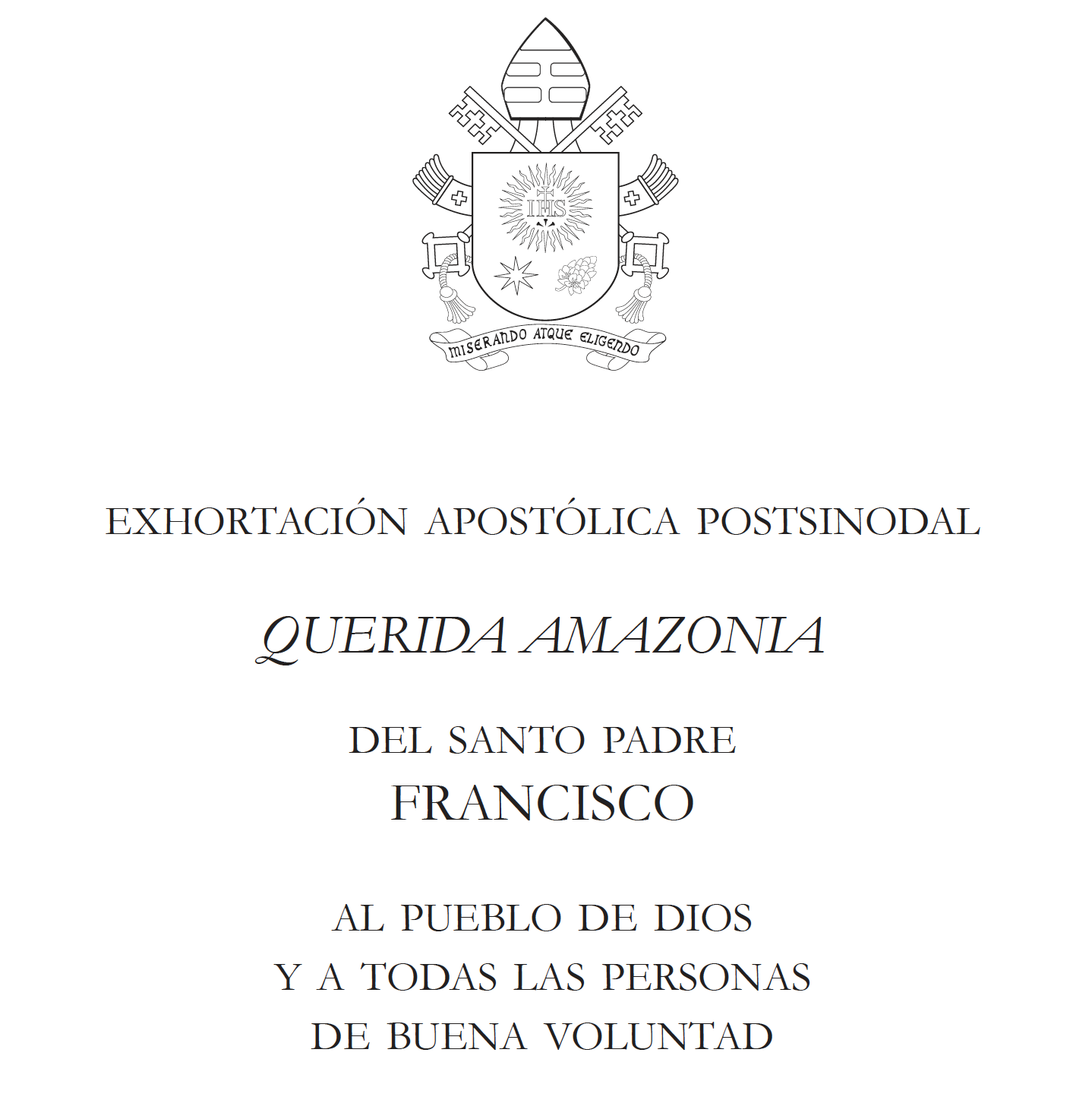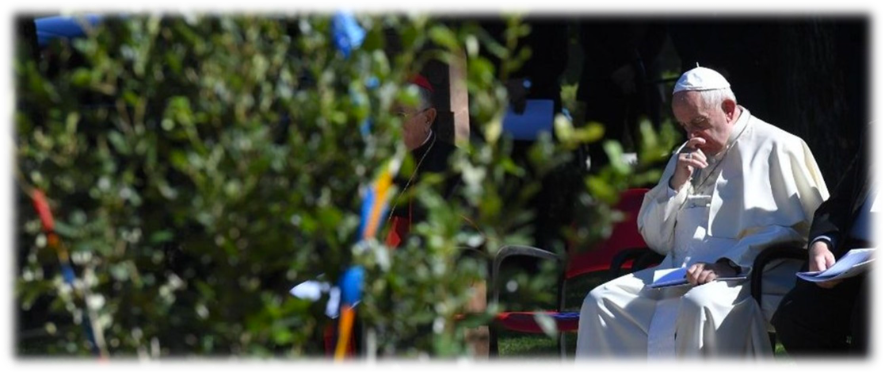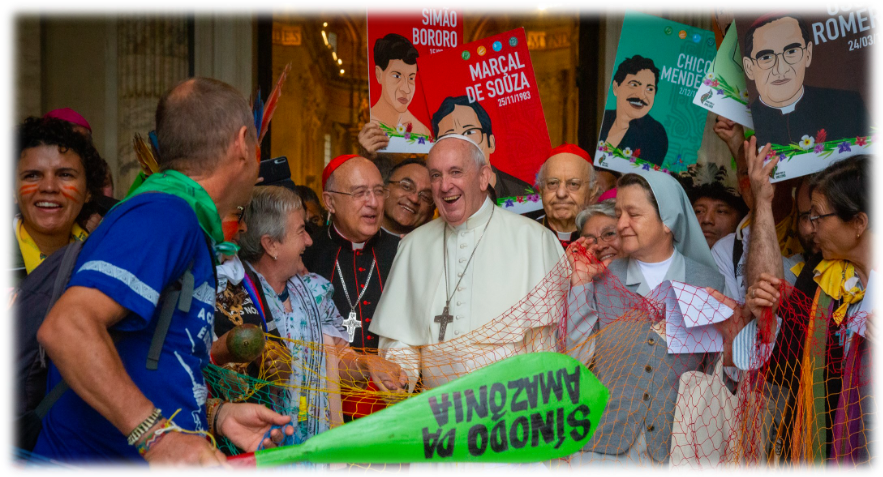
Dreams for the Amazon region

Chapter 1: A social dream before the groan of the earth and the cry of the poor
“I dream of an Amazon region that fights for the rights of the poor, the original peoples and the least of our brothers and sisters, where their voices can be heard and their dignity advanced.”
(Querida Amazonía, 7)
Pope Francis has confirmed, once again, “the intimate relationship between the poor and the fragility of the planet, the conviction that everything is connected in the world” (LS, 16). In the face of a single social and environmental crisis, such as the one that the Amazon region has been experiencing, it is increasingly evident that “a true ecological approach always becomes a social approach, which must integrate justice into discussions about the environment, to hear both the cry of the earth and the cry of the poor” (LS, 49).
Faced with the voracious predation of those who have appropriated goods of the earth, including water, in the Amazon region, through deadly mega-projects, such as, hydroelectric power companies, oil and mineral extractive industries, monocultures, road construction, waterways and railways, among others, Pope Francis’s dream is an echo of the brother’s cry that resonates throughout the history of mankind: “I dream of an Amazon region that fights for the rights of the poor, the original peoples and the least of our brothers and sisters, where their voices can be heard and their dignity advanced.”
Contents:
Chapter 2: A cultural dream, for cultural conversion
“I dream of an Amazon region that can preserve its distinctive cultural riches, where the beauty of our humanity shines forth in so many varied ways.”
(Querida Amazonía, 7)
The cultural diversity of the peoples of the Amazon region points to the possibility of fraternal coexistence based on reciprocity, solidarity, a sense of community, equal rights and participation, recognizing that “everything is interconnected in this common home”. It also points to an inculturated Church that assumes the defense of life, community, land and the rights of its people in a permanent attitude of listening and contemplation that guides our mission and our socio-transformative action.
The “Querida Amazonia” Exhortation considers that inculturation and interculturality are important instruments for achieving cultural conversion. In this perspective, the Church is committed to being an ally of the indigenous populations in Amazonia, to denounce attacks against their lives, ethnocidal and ecocidal predatory development projects, and the criminalization of social movements and their leaders.
Contents:
Chapter 3: An ecological dream, with the hope of ecological conversion
“I dream of an Amazon region that can jealously preserve its overwhelming natural beauty and the superabundant life teeming in its rivers and forests.”
(Querida Amazonía, 7)
In the encyclical Laudato Si’, Pope Francis spread the idea of a broad ecological perspective, an “integral ecology”, that reminds us of the close link between the existence of all dimensions and expressions of life and the geographical space in which it deploys, recognizing and legitimizing diversity. It is in the Amazon region where the concept of integral ecology challenges us to take urgent actions in face of environmental problems that weigh, above all, on indigenous populations.
An ecological conversion to a more sober life is indispensable, which will certainly imply changes in mentality, lifestyle and modes of production and consumption, taking into account the individual and collective interests that surround the appropriation of the earth’s assets .
The roads point to a more fair and supportive integral human development model that respects diversity of the environment and of the peoples that inhabit a geography.
The Apostolic Exhortation of Pope Francis, “Querida Amazonia,” gives new impetus to a Church that is outgoing and generous, who learns together with societies the way to a true integral conversion, committed to harmoniously relating to the Common Home.
“If the care of people and the care of ecosystems are inseparable, this becomes especially important in places where “the forest is not a resource to be exploited; it is a being, or various beings, with which we have to relate” (Querida Amazonía, 42).
“In the Amazon region, water is queen; the rivers and streams are like veins, and water determines every form of life”, (Querida Amazonía 43).
Contents:

Chapter 4: An ecclesial dream, to go from being a Church of visiting to a Church of presence.
“I dream of Christian communities capable of generous commitment, incarnate in the Amazon region, and giving the Church new faces with Amazonian features.”
(Querida Amazonía, n. 7)
In the Final Document of the Synod of the Amazon region, we reaffirmed that the mission is not something optional, but something of ecclesial nature, linked to all the People of God, beyond the ministry that is exercised, ordained or lay. For this it is urgent to open ourselves to the charismatic gifts that the Holy Spirit grants to the Church so that it has life and announces the Good News, inculturated in the multiple reality of the Amazonia; “there is also a need for ministers who can understand Amazonian sensibilities and cultures from within” (Querida Amazonía, 86).
That is why the Pope maintains that “in the specific circumstances of the Amazon region, particularly in its forests and more remote places, a way must be found to ensure this priestly ministry. The laity can proclaim God’s word, teach, organize communities, celebrate certain sacraments, seek different ways to express popular devotion and develop the multitude of gifts that the Spirit pours out in their midst.…” (Querida Amazonía 89).
We must be encouraged to be an outgoing Church, the People of God, who fully assumes evangelization. So,
“A Church of Amazonian features requires the stable presence of mature and lay leaders endowed with authority and familiar with the languages, cultures, spiritual experience and communal way of life in the different places, but also open to the multiplicity of gifts that the Holy Spirit bestows on every one. For wherever there is a particular need, he has already poured out the charisms that can meet it. This requires the Church to be open to the Spirit’s boldness, to trust in, and concretely to permit, the growth of a specific ecclesial culture that is distinctively lay. The challenges in the Amazon region demand of the Church a special effort to be present at every level, and this can only be possible through the vigorous, broad and active involvement of the laity.” (Querida Amazonía, 94).
On the other hand, we cannot be Church if we remain locked in our securities, in sacristies, multiplying the clerical mentality, merely hierarchological, without understanding the “ministerial character” of the sacraments. That is, we cannot be Church if we are not willing to fill our feet with mud to reach what many consider disposable people, or to be where others do not want to be, and to be with whom no one wants to be.
In this context, the need for specific vocations to the ordained priestly ministry along with other ministries must be understood. Therefore, given the pressing need to celebrate the Eucharist in the remote places of the Amazon region, the Pope urges all Bishops
“not only to promote prayer for priestly vocations, but also to be more generous in encouraging those who display a missionary vocation to opt for the Amazon region. At the same time, it is appropriate that the structure and content of both initial and ongoing priestly formation be thoroughly revised, so that priests can acquire the attitudes and abilities demanded by dialogue with Amazonian cultures. This formation must be preeminently pastoral and favour the development of priestly mercy.” (Querida Amazonía 90).
In this tonic, the Pope maintains that:
“…the Eucharist, then, as source and summit, requires the development of that rich variety. Priests are necessary, but this does not mean that permanent deacons (of whom there should be many more in the Amazon region), religious women and lay persons cannot regularly assume important responsibilities for the growth of communities, and perform those functions ever more effectively with the aid of a suitable accompaniment. Consequently, it is not simply a question of facilitating a greater presence of ordained ministers who can celebrate the Eucharist. That would be a very narrow aim, were we not also to strive to awaken new life in communities. We need to promote an encounter with God’s word and growth in holiness through various kinds of lay service that call for a process of education – biblical, doctrinal, spiritual and practical – and a variety of programmes of ongoing formation.” (Querida Amazonía 92-93)
Finally, the path of evangelization in the Amazon region must be marked, irrevocably, by ecumenical, interreligious and intercultural dialogue, by walking and fighting together. The dream is to reach communion, which has to manifest itself in concrete gestures, having the Word of God as a starting point, each time seeking to know the different. Well, it is in diversity that we can find that new paths that we yearn for and that make the good living of our peoples a reality:
“In this regard, the indigenous peoples of the Amazon Region express the authentic quality of life as “good living”. This involves personal, familial, communal and cosmic harmony and finds expression in a communitarian approach to existence, the ability to find joy and fulfillment in an austere and simple life, and a responsible care of nature that preserves resources for future generations. The aboriginal peoples give us the example of a joyful sobriety and in this sense, “they have much to teach us”. They know how to be content with little; they enjoy God’s little gifts without accumulating great possessions; they do not destroy things needlessly; they care for ecosystems and they recognize that the earth, while serving as a generous source of support for their life, also has a maternal dimension that evokes respect and tender love. All these things should be valued and taken up in the process of evangelization.” (Querida Amazonía 71)
Contents:
You can access to the Exhortation from here
